Abstract
Due to a lack of the realization mechanism and operational pattern of the urban-rural integration by land use, this study employs land use to regulate interface elements to achieve urban-rural integration development. Therefore, we analyzed urban-rural reality in Pukou District of Nanjing City, a typical metropolitan fringe of China, and investigated farmers’ willingness of typical representative villages. The results show that (1) According to the combination of resource environment, development intensity and development potential, Pukou District is divided into four land use areas, including optimization integration area, key development area, urban agricultural area, and ecotourism area. Most of the investigated farmers have a strong willingness to realize urban-rural integration by land use; (2) This study proposes an operational pattern of regional land use. The pattern is mainly based on “reality + willingness + policy” by using the three tools of “farmland reconsolidation, village reconstruction and factor reallocation”. It achieves urban-rural integration development through “zoning guidance–willingness driven–pattern selection–differentiated tools”.
1. Introduction
Society and economy of China has rapidly developed since the reform and opening-up policy. Especially, the process of urbanization and industrialization has been speeding up. However, at the same time, the income gap between urban and rural residents has been widening [1]. China has become one of the countries with the most serious income inequality in the world. In 2014, Gini coefficient of urban–rural flow income reached to 2.9159, showing the huge gap between urban per capita disposable income and rural per capita net income [2]. The increasingly serious gap between urban and rural regions not only harms the social fairness and justice, but also affects the production efficiency. Particularly, the problems facing agriculture, rural areas and farmers influence the sustainable development of the economy of China. They are also the potential factors of social and political instability, seriously restricting the socialist modernization of the country [3]. In view of that, some scholars evaluated the urban-rural gap in different regions [2,4]. These studies further revealed the deep-seated reasons for the gap between urban and rural areas. This is mainly due to the social problems inherited from the planned economic system in the past. Especially, the urban-rural dual economic structure is the fundamental cause of the gap between urban and rural regions. Urban-rural integration has been proposed to solve the above problem since the beginning of the new century [5]. Urban-rural integration has gradually become the research focus, and it has been studied by different scholars from different angles, such as the connotation, development strategy and achieving goals of urban–rural integration [6,7,8].
At present, China is in the transformation stage of industry nurturing agriculture and city supporting village [9,10,11]. In this period, the imbalance of urban and rural regions is the prominent contradiction in the current economic and social development. Urban-rural integration is the fundamental way to solve this problem [12]. It considers industry and agriculture, city, and village as a unity. It promotes the integration of urban and rural regions in economy, society, environment, and ecology through system reform and policy adjustment, especially new urbanization and rural revitalization. This will change the long-term urban-rural dual structure and realize a growth target of coordinated development of urban and rural regions. Urban-rural integration needs to solve the problem of man-land relationship between the urban and rural regions. Land is the main carrier and development platform of all economic and social activities in urban and rural regions. All economic and social activities are distributed in the land use space. It is not only the spatial carrier of urban-rural development, but also the motive force of urban-rural development [13,14,15,16]. Land use is playing an increasingly important role in accelerating the urban-rural development and reducing the urban-rural gap [17,18,19]. It can adjust the regional layout of urban-rural relationship and optimize the elements’ allocation between urban and rural regions, so as to build a spatial platform for the urban-rural integration development. Therefore, a large number of researchers have also made relevant studies on the land use in urban-rural regions [5,20]. Especially, many scholars have attempted to solve the problems facing agriculture, countryside and farmers from the perspective of rural geography [21,22]. They have concentrated on the land use change and rural transformation development through theoretical research and practical exploration. It has made significant progresses on their mutual relation, dynamic mechanism and control pattern [23,24,25]. Especially, a series of measures and policies on land use are put forward to be aimed at the phenomenon of “village hollowing” induced by rapid industrialization and urbanization in China [26,27].
As a whole, these studies mainly focus on land use and land management in urban-rural integration development. The proposed land policy promoting the urban-rural integration development is mostly in the qualitative analysis level. There is little research on the combination of the land use and the urban-rural integration. Especially, there is a lack of research on the realization mechanism and pattern of urban-rural integration based on land use. Therefore, this paper attempts to solve the imbalance in urban-rural development by land use from the perspective of rural development. According to the design methodology of pattern [28,29], it will discuss the realization mechanism and operational pattern of land use of urban-rural integration based on farmers’ willingness survey. The study will provide the theoretical basis and practical reference for urban-rural integration development.
2. Urban-Rural Integration Regulated by Land Use
An urban-rural system consists of two subsystems: urban subsystem and rural subsystem [30]. Once the development reaches to the middle stage of industrialization, the imbalance between the urban and rural development will become a major obstacle, and it must rely on urban-rural integration to realize the regional socioeconomic rapid development.
2.1. Definition of UrbanRural Integration Systems
Interface theory mainly studies the system boundary with maintenance and exchange functions, and is widely used in various fields. In recent years, interface theory has been gradually introduced into regional science to form spatial interface theory [31,32,33]. We thus extend the theory of spatial interface to the urban-rural integration. Urban-rural integration is actually to coordinate the relationship between the urban and rural regions. However, due to the development gap and the urban-rural dual structure, there is a fuzzy interface between the urban and rural regions. There is a significant gap between the social and economic development within and outside the boundaries. This boundary may be tangible, such as administrative divisions, geographical landscapes, etc. It may also be intangible, such as the household registration system and the urban-rural dual structure, etc. The location of fuzzy interface is related to many factors that affect the level of social and economic development in urban-rural regions. They constitute a set of factors F. Therefore, we define two subsystems of urban and rural regions as urban-rural integration system. The system is mainly affected by the fuzzy interface, and this fuzzy interface is determined by the factor set F which is composed of a series of urban-rural social, economic, and environmental factors. The purpose of urban-rural integration is to optimize the range of the elements in the factor set F through a series of regulatory measures and policies. Once urban-rural integration breaks the barriers between the urban and rural regions, it will promote the two-way flow of various elements in urban-rural region, and it will finally achieve the harmonious coexistence of urban-rural regions.
According to the above definition, the interface between the urban and rural integration systems can be divided into the following three types in a broad sense (Figure 1). They include (a) the interface between the city and the country: there is a vague interface between the urban system and the rural system. This interface is tangible; (b) the interface before and after urban-rural integration: when we consider the urban-rural regions as a whole, it is a system before the urban-rural integration and it is also a system after the urban-rural integration. There is an interface between the two systems, and this interface is invisible; (c) the interface between the urban and rural system: when we consider the urban-rural regions as a whole, there is also an interface between an urban-rural system and another adjacent urban-rural system.
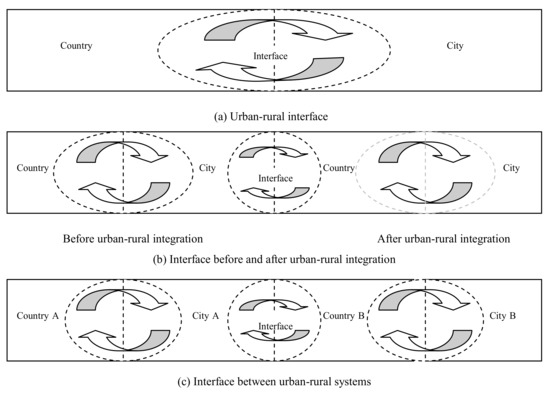
Figure 1.
Interface types of urban-rural integration. They include (a) urban-rural interface: there is a vague interface between the urban system and the rural system. This interface is tangible; (b) interface before and after urban-rural integration: when we consider the urban-rural regions as a whole, it is a system before the urban-rural integration and it is also a system after the urban-rural integration. There is an interface between the two systems, and this interface is invisible; (c) interface between the urban and rural system: when we consider the urban-rural regions as a whole, there is also an interface between an urban-rural system and another adjacent urban-rural system.
2.2. Influencing Factors of Urban-Rural Integration
All kinds of material flow, energy flow, and information flow are intertwined with each other between urban and rural regions. They act together on urban-rural regional system. The main factors hindering urban-rural interface process include the objective factor, subjective factor and institutional factor. The objective factor is urban-rural reality. The subjective factor is farmers’ willingness, and the institutional factor is government policy. Urban-rural reality and farmers’ willingness provide the government with necessary information on urban-rural integration. They are the basis for government to formulate relevant policies for balancing urban and rural regions. Government policy, in turn, will affect urban-rural reality and farmers’ willingness. The main purpose of government policy is to change urban-rural reality and to increase farmers’ income. Once it leads to narrow the gap between urban and rural regions, it will achieve urban-rural integration. Farmers’ willingness specifically reflects the farmers’ feeling to urban-rural reality. Urban-rural reality will, in turn, affect the wishes of farmers. Three factors act on the aim of balancing urban and rural development. Figure 2 shows the multi-subjects operating mechanism of urban-rural integration.
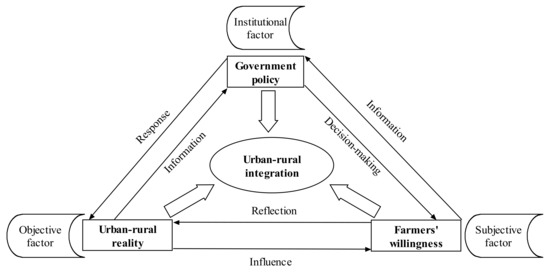
Figure 2.
Multi-subjects operating mechanism of urban-rural integration.
2.3. Regulation of Land Use in Urban-Rural Integration
The system of urban-rural integration mainly involves three subsystems. They include natural subsystem, economic subsystem and social subsystem. Three subsystems interact with each other, and material circulation and energy flow in the system depend on the carrier of land. The spatial pattern and spatiotemporal change of land use can reflect material circulation and energy flow in the urban-rural system. They interact with each other, which is a kind of coupling relationship [24,25]. Land can build a spatial platform of mutual connection between urban and rural regions. As a link, land can realize the effective allocation of various factors between urban and rural regions [34,35]. It will promote the coordinated development of urban and rural economy. The structure adjustment and spatial optimization of land use is an important method and means to realize urban-rural integration. Therefore, land use strategy can be applied to urban-rural integration. It can achieve urban-rural integration by the strategy of land use in urban-rural regions. Land use will realize the adjustment and optimization of quantity, structure and utilizing way of urban-rural land use, and land use strategy can eliminate flow obstacles to the various elements between urban and rural regions.
Based on the above analysis, the main factors that affect urban-rural integration include urban-rural reality, farmers’ willingness and government policy. Moreover, urban-rural integration is ultimately to achieve four major goals including “well-off life, prosperity production, sharing welfare, and beautiful ecology”, and it must regulate the system elements to achieve the goals of urban-rural integration. Therefore, three regulation tools of land use are put forward. They include farmland reconsolidation, village reconstruction, and factor reallocation. It will optimize the scope of system elements in urban-rural integration through three tools. It can also eliminate fuzzy boundaries between two systems of urban and rural regions and it will finally achieve the goal of urban-rural integration. The system regulation mechanism of urban-rural integration based on land use is shown in Figure 3.

Figure 3.
Regulation mechanism of land use in urban-rural integration.
The relationship between three tools is analyzed as follows. In the process of farmland reconsolidation, abandoned or scattered residential areas will be demolished. Once the old houses are demolished, the new residential area will guide the farmers to live in a unified way [36]. Farmland reconsolidation will be also conducive to large-scale operation of agricultural land. A large number of surplus labor will be transferred to non-agricultural production activities [37,38,39,40,41]. Once the village reconstruction is implemented, in addition to meeting the construction land need of new residential area, a large number of surplus indicators of rural construction land will be generated. The surplus rural construction-land indicators will be provided to the city to meet the needs of economic construction and industrial development by means of space replacement or land-element circulation [42,43,44]. Moreover, the farmland will be consolidated and managed in a unified way. In addition, the circulation of land elements will promote the implementation of large-scale land management. The effective transfer of rural surplus labor will be beneficial to village reconstruction and farmland reconsolidation. The spatial replacement of rural surplus construction land index will accelerate the rapid development of economy and society between urban and rural areas [45,46,47].
3. Data and Methods
3.1. Study Area
Nanjing City, the provincial capital of Jiangsu province, is an important central city in eastern China. Due to be located in the Yangtze River Delta, the city has experienced rapid growth in economic and social development since 1978. However, influenced by traditional urban-rural dual structure, Nanjing is still a typical city with strong center and weak edge. Pukou District (118°21′~118°46′ E, 30°51′~32°15′ N), located in the northwest of Nanjing, is a typical suburb of Nanjing (Figure 4). This district is on the north bank of the Yangtze River, facing Gulou, Jianye, Yuhuatai, and Jiangning Districts of Nanjing city across the river. It covers an area of 913.75 km2. The topography of Pukou District is mainly low mountains, hills, plains and hillocks. The area belongs to the northwest edge of hilly area in Nanjing–Zhenjiang–Yangzhou region, with high terrain in the middle and low terrain in the north and south. Pukou is adjacent to the Yangtze River in front and Chuhe River in the back. There are alluvial land along the river bank. According to the terrain difference and geomorphic characteristics, there are four large areas of polder along the Yangtze River, polder along the Chuhe River, the mountains and the hills. According to the geographical location, the district is mainly controlled by the subtropical monsoon climate. According to the statistics data of many years, the annual mean rainfall in Pukou District is 1102.2 mm, and the annual mean temperature is 15.4 °C. Pukou District is agricultural production base of Nanjing City owing to be located on a fringe area of the metropolis. The total population of Pukou District in 2018 was 3.796 × 105, and it achieved a GDP of RMB 3.60 × 1010.
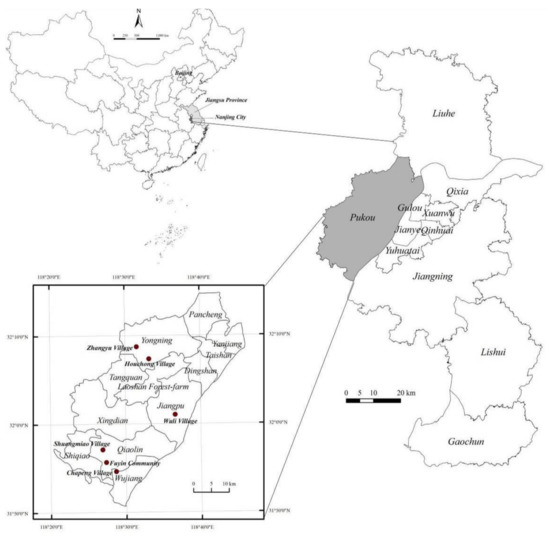
Figure 4.
Location of the study area.
3.2. Analysis of Urban-Rural Reality Based on Land Function Zoning
Urban subsystem and rural subsystem are interlinked in a regional territorial system. Urban subsystem is carriers for all kinds of production factors including labor, land, and capital in two subsystems. It needs to transfer of production factors between two systems to achieve the goal of urban-rural integration. Therefore, the rapid development of regional urbanization and industrialization is required. With regard to this, regional function zoning of land use is an effective approach. The approach promotes urban-rural integration development by guiding industrial distribution and structural optimization, facilitating the socioeconomic development, and realizing regional urbanization and rural industrialization. Therefore, regional function zoning of land use must take many factors into consideration from the perspective of economic and social development. Thus, this study establishes the index system of regional function zoning of land use in Pukou District. The system includes three aspects of resource environment constraints, current exploitation intensity and future development potential. It can be seen from Table 1.

Table 1.
Index system of regional function zoning of land use in Pukou District.
According to the index system in Table 1, 11 towns in Pukou District are taken as evaluation units and data from each town can also be collected. Based on the data of land use change in Pukou District, the current data of forest coverage, water area proportion and urban-rural construction land proportion of each town are obtained. The importance of urban nodes is obtained according to the following formula: , where Ii is the importance of urban node i, Pi is the population of urban node i (person), Fi is the financial revenue of urban node i (Ten thousand RMB), is the average population of urban nodes in the zone (person), is the average fiscal revenue of urban nodes in the zone (Ten thousand RMB), α1 and α2 is the weight of each index. Other index are calculated directly by the data obtained from the statistical yearbook of Pukou District.
The model of grey relational projection is applied to calculate three values of grey relational projection of resource environment constraints, current exploitation intensity and future development potential [48]. This paper first establishes a sample matrix composed of evaluation samples and ideal samples (the most value of evaluation samples): . Then, this article normalizes the elements in the sample matrix and calculates grey correlation coefficient between each evaluation sample and the ideal sample, where these values are made up of judgment matrix of grey correlation degree: . The weight of each evaluation index is calculated by the method of principal component analysis. The eigenvalues and eigenvectors of each index are calculated by SPSS software, and the index weight is then determined. These weights can be seen from Table 1. Each index weight is normalized: , where is the index weight in Table 1. On this basis, the weight’s weighting vector is constructed. Once the weighted vector acts on the judgment matrix of grey correlation degree, this will form the extended judgment matrix of weighted grey correlation degree: . Since each sample in the augmented weighted grey incidence judgment matrix is regarded as a multidimensional vector, the cosine value of grey projection angle between evaluation sample and ideal sample is calculated respectively: . The size of sample module has also been calculated. Finally, the value of grey correlation projection of each sample on the ideal sample is calculated by the product of the size of the module and the cosine of the included angle. According to the above calculation results, the frequency histogram of three grey correlation projection values, including resource environment constraints, current exploitation intensity, and future development potential, is drawn respectively. According to the obvious inflexion points on the frequency histogram, three levels are divided, which are assigned as 1, 2, and 3 from low to high.
In this paper, classification method of three-dimensional magic square map is used for regional function zoning of land use [49]. Therefore, a three-dimensional coordinate system of x, y, and z axes is established. Three axes are respectively represented by resources environment constraints, current exploitation intensity and future development potential. Three points are selected on the x, y, and z axis from origin outwards equidistant, respectively representing three levels of the three subsystems. Then, we draw three vertical lines of x, y, and z axis from these points to form three-dimensional magic square (3 × 3 × 3). This cube has 27 cube units in total. Each cube unit is denoted by the value (x, y, and z). It represents the combination type of resource environment—exploitation intensity—development potential, in which resource environment constraints is x-level, current exploitation intensity is y-level, and future development potential is z-level. Finally, according to the corresponding relationship between magic square map unit and functional area type (Table 2), regional function zoning of land use is divided.

Table 2.
Corresponding relation between units of magic cube and types of regional function zoning of land use
3.3. Investigation of Farmers’ Intention Based on Land Use
In order to further know the willingness of farmers to achieve urban-rural integration in different regions, six representative villages in Pukou District were randomly selected from each type of area in accordance with the principles of simultaneously considering comprehensiveness, representativeness, and typicality (Figure 4). Wuli Village in Jiangpu is the typical village of the optimization integration area. Fuyin Community and Shuangmiao Village in Qiaolin are the representative villages of the key development area. Chapeng Village in Wujiang is selected as the representative village of the urban agricultural area. Houchong Village and Zhangyu Village in Yongning are selected as the typical village of the ecotourism area.
The cultural level and acceptance ability of farmers were fully considered in the design of the questionnaire, so the easy to understand questions was adopted in the way of questioning. The questionnaire was mainly composed of single choice questions, followed by multiple choice questions, and a small number of subjective questions. In addition, in order to obtain the true information and judge the validity of the questionnaire, some hidden repeated questions were designed to judge whether the farmers’ answers were consistent. The core of the questionnaire design was the farmers’ willingness to urban-rural integration. Therefore, the questionnaire designed three land use issues to promote urban-rural integration, including farmland reconsolidation, village reconstruction and factor reallocation. The data were collected by questionnaire survey, personal interview and small forum. Among them, questionnaire survey is the main data collection method, which adopts the combination of centralized interview and door-to-door interview. After the questionnaire is collected, it would be screened. The invalid questionnaire would be removed, and the valid questionnaire would be numbered. We test the validity of sample data by the use of exploratory factor analysis, and some questions in the questionnaire are adjusted based on the tested results.
This survey collected 205 questionnaires, including 201 valid ones, with an effective rate of 98.05%. Considering the total population, sex ratio and education level, the sample proportion of each village is different. As can be seen from Table 3, the samples of Wuli Village, Fuyin Community, Shuangmiao Village, Chapeng Village, Houchong Village, and Zhangwei Village were 20, 41, 45, 32, 29 and 34, respectively, accounting for 9.95%, 20.40%, 22.39%, 15.92%, 14.43%, and 16.92% of the total samples. The investigation database is finally formed by using the MS-Excel® software to input the questionnaire data on the willingness of farmers to achieve urban-rural integration in Pukou District. Then, mathematical statistics analysis is carried out by the use of the MS-Excel®.

Table 3.
Distribution of the investigated samples.
4. Results and Discussion
4.1. Urban-Rural Reality Based on Land Function Zoning
Figure 5 shows regionalization of resource environment restriction, current exploitation intensity, and future development potential in Pukou District. According to the zoning, Pukou District is divided into four land use areas, including optimization integration area, key development area, urban agricultural area and ecotourism area.
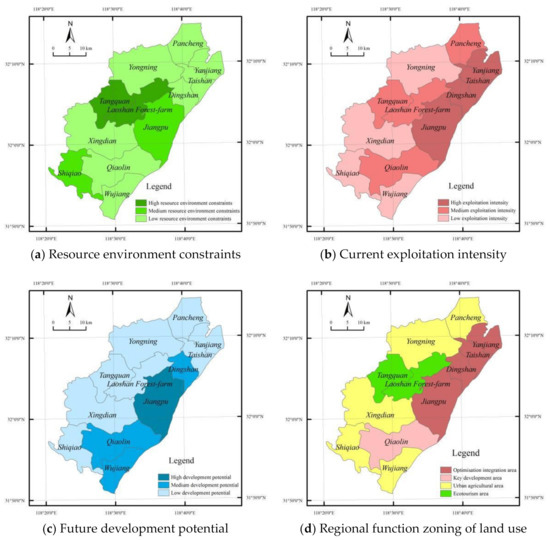
Figure 5.
Regionalization of resource environment restriction, current exploitation intensity, future development potential in Pukou District. It shows regionalization of (a) resource environment restriction, (b) current exploitation intensity, and (c) future development potential in Pukou District. Regional function zoning of land use (d) shows the combination type of resource environment—exploitation intensity—development potential. According to the zoning, Pukou District is divided into four land use areas, including optimization integration area, key development area, urban agricultural area and ecotourism area.
- (1)
- Optimization integration area refers to the area with low resource environment constraints, high current exploitation intensity and high future development potential. This area mainly includes Jiangpu, Yanjiang, Taishan, and Dingshan (Figure 5d). These four towns are the central urban regions of Pukou District, of which Jiangpu is the seat of government in Pukou District. It can be seen from Figure 5a that except Jiangpu is in the state of medium resource environment constraints; the other three streets are in the state of low resource environment constraints. Due to the radiation effect of center of Nanjing City, current exploitation intensities of the four towns are relatively high (Figure 5b). Especially, Jiangpu has the largest population density. The population density, average land GDP and proportion of urban-rural construction land in Taishan are 2377.323 people/km2, 8, 8864,500 RMB/km2, and 74.50%, respectively, and three indexes are the highest in all towns. Moreover, proportions of urban population in four towns are as high as 100%. This area is close to the Yangtze River and faces the center of Nanjing City across the river, so it has prominent advantages in location and traffic. As the political, economic, and cultural center of Pukou District, this area is also the sub-center of Nanjing metropolitan area and the main construction zone of Jiangbei New District. So measures should be taken to strengthen the function of transportation center and promote population concentration, so as to promote the process of urbanization and industrialization. In addition, due to abundant scientific and educational resources, it should take high-tech Development Zone of Pukou District as the leader, promote the upgrading of industries in the area, and realize the rapid development of high-tech industries.
- (2)
- Key development area refers to the area with low resource environment constraints, low current exploitation intensity, but high future development potential. As can be seen from Figure 5d, the area is mainly Qiaolin. Qiaolin is less constrained by resource environment. Current exploitation intensity of this area is also at a medium level (Figure 5b). As the town is adjacent to the central of Pukou District, it has obvious location advantages, complete infrastructure, and great potential for future development (Figure 5c). Due to that Qiaolin has a good foundation for industrial development, it should further enhance the industrial scale, improve the level of industrialization and promote the development of urbanization in the future. As a key new street in Nanjing City, Qiaolin also should undertake the industrial transfer of central region of Pukou District and share the functions of the industrial center of the district. Further, this area should vigorously develop metal products industry, new material industry, electronic and electrical industry, and build into a comprehensive industrial new town along the Yangtze River. At the same time, this area should gradually become an advanced manufacturing base and regional logistics base. Moreover, the area should further develop the agricultural and sideline products deep processing industry and build into a regional material distribution center.
- (3)
- Urban agricultural area mainly refers to the area with low resource environment constraints, current exploitation intensity and future development potential. As shown in Figure 5d, this area mainly includes Pancheng, Yongning, Xingdian, Shiqiao and Wujiang. These towns have a large proportion of agricultural population, and due to be covered by a large proportion of agriculture and forestry land, these areas are the main grain producing areas of Pukou District. In the future, the cultivated land should be strictly protected to better promote social and economic development in these areas, and the surplus agricultural population should be encouraged to go out for employment. It also should promote the largescale and intensive development of agriculture and develop agricultural industries such as characteristic vegetables, seedlings and flowers, livestock and poultry, and special aquatic products according to local conditions. Especially, it should focus on the layout of agricultural production bases in Yongning, Xingdian, Shiqiao, Wujiang, and other towns. Thus, the pattern of agricultural industry will be formed with urban agricultural ecological area, suburban production leisure area and suburban ecological agricultural area. Moreover, it is also necessary to make full use of natural ecological landscape of modern urban agriculture to develop agricultural tourism industry with functions of sightseeing leisure, cultural popularization, experience participation, and tourism vacation.
- (4)
- Ecotourism area refers to the area with high resource environment constraints, low current exploitation intensity and future development potential. This area mainly includes Tangquan (Figure 5d). The area is adjacent to Laoshan Forest-farm in the south, with the proportion of forest land area as high as 37.32%. Due to be rich in mountain forest resources, it is an important ecological regulation area in the whole district. At the same time, Tangquan is rich in geothermal resources, and is the famous tourist resort. Therefore, based on Laoshan Forest-farm and hot spring resource, this area should be built into a national tourist resort and a new tourist town. This area will gradually become an important conference and tourist resort center in Nanjing City.
4.2. Farmers’ Intention Based on Land Use
4.2.1. Willingness to Farmland Reconsolidation
Table 4 shows the willingness of different types of rural households with the farmland reconsolidation. Most investigated farmers in Pukou District have strong desire to take farmland reconsolidation, among which 29.83% and 53.04% express extreme willingness and willingness, respectively. In addition, some respondents have implemented farmland reconsolidation, they did not answer this question. Farmers in Zhangyu Village have strong desire to take farmland reconsolidation, especially the proportion of farmers who answer “extreme willingness” is as high as 47.06%. Farmers in Houchong Village and Chapeng Village have also the willing to take farmland reconsolidation, especially the proportion of farmers who answer “willingness” is as high as 71.43% and 68.75%, respectively. This shows that farmers in Pukou District have strong desire to take farmland reconsolidation. It will increase the output and benefit of farmland, and then increase the income level of farmers. This also reflects from one side that the current farmland output in Pukou District is low, which leads to low income of farmers. Farmers are eager to improve farmland output through farmland reconsolidation and other measures. Once the production efficiency of farmland is improved, the income of farmers will increase.

Table 4.
Intention of the investigated peasants in farmland reconsolidation.
4.2.2. Willingness to Village Reconstruction
It can be seen from Figure 6 that when be asked on the most desirable way of living, 50.98% of the respondents think that self-built housing is their best way of living. A total of 45.10% of the respondents think that government resettlement community is the best way to live. Only 3.92% of the households answered that “urban self-purchased commercial housing” is the best way to live. This shows that Pukou farmers have a strong attachment to the land, and they are more attached to traditional living mode.
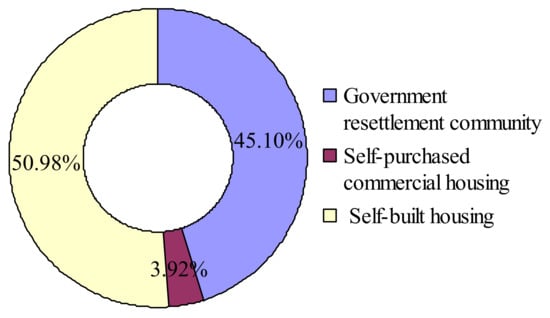
Figure 6.
Willingness of the investigated peasants to new living patterns for village reconstruction.
The respondents’ answers to resettlement compensation are relatively scattered, among which the proportion of providing resettlement housing is the highest, accounting for 23.08%. Secondly, 21.92% of the farmers think that they should compensate money. In addition, 20.77% of the farmers think that they should provide social insurance such as education and training, retirement, medical, and unemployment insurance. A total of 19.23% of the total samples are the farmers who think that the best way to compensate is to reserve land-share dividends (Figure 7). This shows that farmers’ desire for resettlement compensation is diversified. Farmers are not only satisfied with the traditional material life such as housing and currency, but also worried about their future life, hoping that the government can provide better social security.
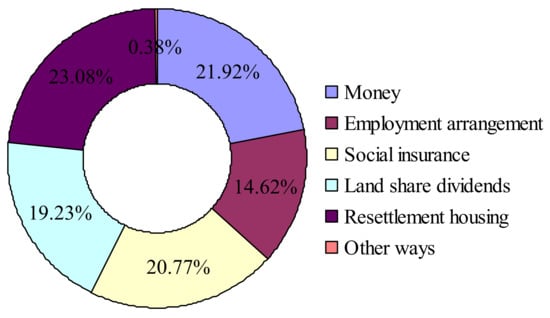
Figure 7.
Willingness of the investigated peasants to resettlement compensation for village reconstruction.
4.2.3. Willingness to Factor Reallocation
Table 5 shows the willingness of different types of rural households with the land transfer. Most investigated farmers in Pukou District have desire to take the land transfer, among which 18.68% and 46.15% express extreme agreement and agreement, respectively. In addition, some respondents have implemented the transfer of land management rights, they did not answer this question. Farmers in Zhangyu Village have strong desire to take land transfer, especially the proportion of farmers who answer “extreme agreement” is as high as 32.35%. Farmers in Fuyin Community have also the willing to carry out farmland consolidation, especially the proportion of farmers who answer “agreement” is as high as 50.00%. This shows that farmers in Pukou District have strong desire to take land transfer. It reflects that farming cannot bring basic life guarantee to the farmers in Pukou District. They prefer to change the current mode of production through land transfer. Large-scale land management will improve production efficiency and living standard.

Table 5.
Intention of the investigated peasants to transfer land management rights.
4.3. Government Policy on Land Use under Different Regional Types
Rural areas are not only the space for farmers’ life and agricultural development, but also the carrier of urban-rural integration. According to their location conditions, resource endowments, economic basis, and industrial advantages, different rural areas have different advantages and characteristics. Therefore, we should choose different types of land operation pattern under the guidance of land use zoning according to farmers’ willingness.
4.3.1. Industrial Enterprise Driven Type
The main characteristics of the rural areas driven by industrial enterprises are solid industrial foundation and developed industrial economy. This type of rural development mainly relies on industrial enterprises, integrating land, labor, capital, technology, and other elements, so as to realize urban-rural integration. Through strengthening industrial enterprises, we can promote the development of rural social economy, increase the income of farmers, improve the level of welfare, and finally achieve urban-rural integration. This type is mainly represented by Wuli Village.
The operation pattern of land use based on industrial enterprise driven type is shown in Figure 8. Farmland reconsolidation focuses on inefficient land use, waste land use and polluted land use in the development process of industrial enterprises, so as to reuse stock construction land. Through village reconstruction, we can guide farmers to live in a unified way and improve their living environment, which can promote economical and intensive use of land. This will provide land, labor, and other basic support for the development of rural industrialization. It should take measures such as undertaking industrial transfer, so as to optimize industrial structure and upgrade industrial level. Rural industrialization will increase local transfer of surplus labor, increase farmers’ incomes, strengthen collective economic strength of villages, and raise the level of rural welfare. The development of industrial economy will also promote the large-scale operation of agriculture, the development of agricultural specialization and industrialization, and promote the development of agricultural tourism. The goal of urban-rural integration can be achieved through the way of promoting agriculture with industry.
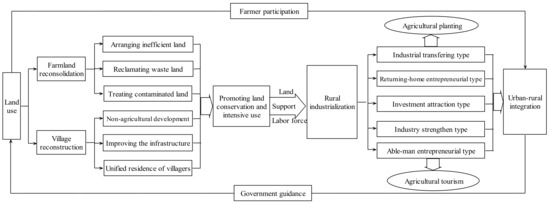
Figure 8.
Operational pattern of land use based on the development of industrial enterprise.
4.3.2. Village Transformation to Urban Integration Development Type
Due to that it is the transitional stage, there are a series of problems in the process of “village transformation to urban community”. Therefore, it must take the transformation of development way in order to realize urban-rural integration in this type of rural areas. It should take measures such as building new communities to turn villages into cities and farmers into real citizens. This type is mainly represented by Fuyin Community.
The operational pattern of land use based on village transformation to urban community is shown in Figure 9. Under government guidance and farmers’ participation, we should take land consolidation through increasing the intensity of land circulation. It will increase the number of cultivated land and improve the quality of cultivated land. Land scale-management will also promote the industrialization of agriculture, providing basic guarantee for the construction of urbanization. Meanwhile, we should renovate rural residential land and gradually guide the farmers to live in a unified way based on controlling village expansion boundary. It will promote the economical and intensive use of land. Saving construction land after land reconsolidation can provide development space for urban construction. Moreover, driven by the radiation of urbanization, this will speed up the transfer of rural surplus labor to non-agricultural industries, making farmers gradually get rid of the dependence on land and change the traditional agricultural production mode. We also should improve land acquisition system to protect the rights and interests of landless farmers and to promote non-agricultural employment. On this basis, it should promote the upgrading of rural industries and accelerate the process of urbanization by guiding industrial cluster development. This will realize the transformation from rural land to urban land, from farmers to urban residents, and from rural areas to urban communities, and finally realize urban-rural integration.
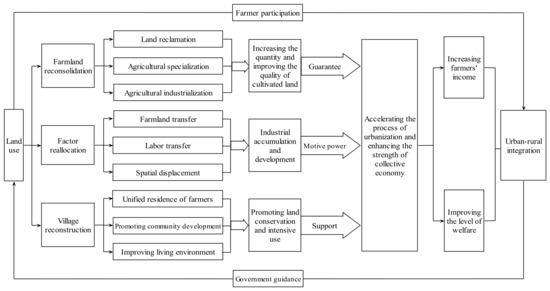
Figure 9.
Operational pattern of land use based on village transformation to urban community.
4.3.3. Enclave Economy Spanning Type
Enclave economy refers to a cooperative development pattern in which the governments of developed and underdeveloped regions break the restrictions of administrative divisions and achieve mutual benefit through joint cooperation. This pattern moves the funds and projects of output areas to industrial base of input areas which is not subordinate to each other in administration. It makes full use of comparative advantages of regions through breaking the boundaries of administrative regions and realizes coordinated development among regions. This type is mainly represented by Shuangmiao Village.
Operational pattern of land use based on the development of enclave economy is shown in Figure 10. It should improve existing land-stock cooperatives and increase land circulation through subcontracting, leasing, transfer, exchange, and other forms. We should guide farmers to live in a unified way and build new communities through the implementation of land policies so as to improve the level of intensive use of land and promote scale concentration of land. Under government operation, we should actively introduce enterprises in line with industrial policies into industrial concentration areas by undertaking industrial transfer in developed areas. Land stock cooperative of the village can provide surplus index of construction land to input enterprises by unified operation. Part of enterprise income is left to land cooperatives to strengthen collective economy. The farmers on original land-share part of enterprise income through shares to solve their life worries. According to land suitability, land cooperatives adjust agricultural planting structure, conduct largescale operation, and build agricultural planting base. This will provide a strong foundation for the development of modern agriculture, facility agriculture, and efficient agriculture. In addition, it can improve the efficiency of agricultural land through the development of agricultural tourism, which will provide strong support for rural life security. Urban-rural integration will finally be realized.

Figure 10.
Operational pattern of land use based on the development of enclave economy.
4.3.4. Rural Tourism Inspiring Type
Rural tourism is one of main driving forces for the coordinated development of urban and rural areas. It should vigorously develop rural tourism in the form of agritainment and sightseeing garden to promote the combination of primary and tertiary industries. This type is mainly represented by Chapeng Village.
Operational pattern of land use based on the development of rural tourism is shown in Figure 11. We should increase land circulation by means of leasing operations, joint-stock cooperation, and contracting operations, so as to promote land scale concentration. Land cooperatives manage largescale land in a unified way. According to local conditions, they cultivate rich rural tourism resources by adjusting agricultural planting structure to develop ecological agriculture, scale agriculture, and efficient agriculture. Through the implementation of land policy, we can promote village reconstruction, guide farmers to live in a unified and centralized way, and build new communities. By improving the level of intensive use of land, it will provide enough space for the development of tourism facilities, and then provide land support for the development of rural tourism. At the same time, on the one hand, farmers with better economic conditions should be encouraged to spontaneously carry out agritainment tourism. On the other hand, we can establish tourism development companies through land cooperatives. On this basis, tourism development companies cooperate with investors to develop various forms of rural tourism by relying on agricultural plantations. Land cooperatives provide labor, land, and other capital, and investors provide capital, technology, and other capital. In addition, we should take surrounding urban population as main target group, and carry out various forms of rural tourism, such as sightseeing, participation and experience, leisure and vacation, folk culture, and so on. This will increase the income of farmers and ultimately achieve urban-rural integration.
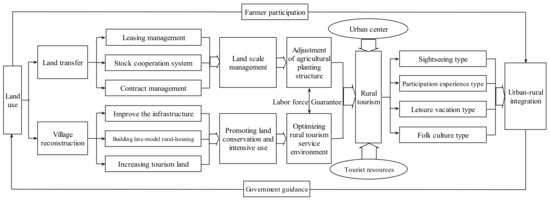
Figure 11.
Operational pattern of land use based on the development of rural tourism.
4.3.5. Characteristic Agriculture Development Type
The development of characteristic agriculture in rural areas has formed some characteristic agricultural products due to its traditional agricultural basis. Therefore, this type of rural areas can rely on advantage product of regional agricultural characteristics, and implement agricultural scale and specialized management. On this basis, we should gradually extend industrial chain, realize the industrialization of agricultural production, and improve the income of farmers. This type is mainly represented by Houchong Village.
Operational pattern of land use based on the development of characteristic agriculture is shown in Figure 12. We should promote scale concentration of agricultural land. According to local planting tradition and characteristics, it should carry out largescale management. Through cultivating brand agricultural products, we should vigorously develop modern agriculture and take the road of agricultural specialization and industrialization. At the same time, through the implementation of land policy and the establishment of rural construction-land market, we can promote the concentration of construction land. The government should guide farmers to live in a unified way and enhance agglomeration effect of population. It will also improve living environment of farmers and drive the development of new rural communities through village reconstruction. We should also establish agricultural production service-center to guide rapid transfer of surplus labor gradually and provide better service for the development of modern agriculture. While vigorously developing modern agriculture, we should actively expand industrial chain to actively cultivate rural eco-tourism resources by relying on efficient agriculture and facility agriculture. On this basis, it should focus on the development of various forms of rural tourism industry, including urban leisure, farm experience, agricultural industrial park, ecological tourism and characteristic industry. With active participation of farmers and the guidance of government, we will find a way to develop rural economy with “characteristic agriculture + rural tourism”.
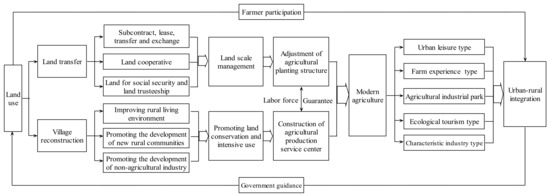
Figure 12.
Operational pattern of land use based on the development of characteristic agriculture.
4.3.6. Crossing-Village Cooperation Binding Type
Due to the limitation of location conditions or the influence of natural disasters, this part of rural areas has not formed its characteristics and advantages. Therefore, in addition to relying on their own economic strength, it needs to promote the binding of economically backward villages and economically developed villages with the help of the government. This type is mainly represented by Zhangyu Village.
Figure 13 shows operational pattern of land use based on crossing-village cooperation binding type. With the help of government, the villages with better economic development and higher pressure of land demand should be bound with the villages with poor economic development. On the basis of respecting farmers’ willingness, the whole villager of poor villages should be relocated. The residents of poor villages and economically developed villages live in a unified place with better location conditions and build a new type of community. Farmers in economically poor villages voluntarily transfer contracted land management right and use right of homestead to land cooperatives. Economically developed villages provide funds and technology to help economically poor villages carry out land consolidation. The large-scale management of land should be carried out according to local conditions. On this basis, we should develop ecological agriculture, modern agriculture and agricultural tourism to realize the specialization and industrialization of agriculture. Economically poor villages strengthen collective economy by reclaiming homestead and providing land indicators to economically developed villages. Poor villages provide rich labor resources to developed villages through unified organization of employment training, and developed villages undertake certain transfer tasks of rural surplus labor. Farmers, as shareholders of land cooperatives, will enjoy the dividend and value-added income of land shares. Their lives and incomes will be guaranteed and finally rural modernization will be realized.
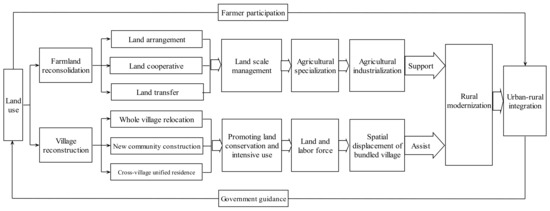
Figure 13.
Operational pattern of land use based on village-village combine.
4.4. Operational System of Land Use Based on Reality, Willingness and Policy in Urban-Rural Integration
This article has taken basic reality analysis of urban-rural integration and internal driving-willingness investigation of urban-rural integration in the research area. We propose an operational pattern of land use. The model is mainly based on “reality + willingness + policy” by using the three tools of “farmland reconsolidation, village reconstruction and factor reallocation”. It achieves the regional urban-rural integration development through “zoning guidance–willingness driven–pattern selection–differentiated tools” (Figure 14).
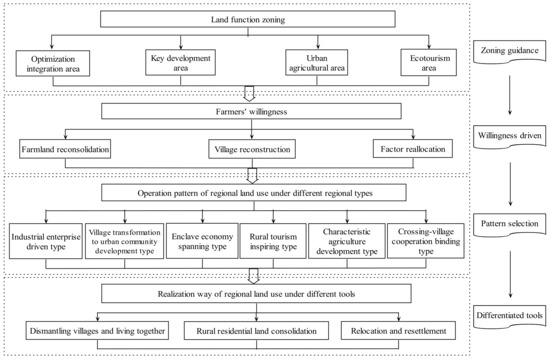
Figure 14.
Operational system of land use based on reality, willingness, and policy.
As can be seen from the figure, the system is mainly composed of the following four parts:
- (1)
- Zoning guidance
In order to achieve urban-rural integration in a region, we should firstly divide the functional regions of land use according to socio–economic development and land-use reality. Land use zoning is conducive to strengthening the division of labor and cooperation among regions, so as to highlight the functionality and coordination of different regions. Under the guidance of different zoning functions, industrial layout and structure will be further optimized. This will further speed up regional urbanization and rural industrialization, so as to build a good basic platform for the urban-rural integration development. Based on current situation of research area, optimization integration area should focus on the integration of resources, promote industrial upgrading, and develop high-tech industries. Key development area should enhance industrial scale, undertake industrial transfer, and establish into an advanced manufacturing base. On the basis of strict protection of cultivated land, urban agricultural areas should develop characteristic agriculture according to local conditions, and promote the development of agriculture in scale, industrialization, and intensification. Based on Laoshan National Forest Park, ecotourism area should be built into a national–level tourism resort to play its ecological regulation function.
- (2)
- Willingness driven
At the same time, urban-rural integration also needs to adhere to the principle of “people-oriented”, respect the wishes of farmers, and give full play to subjective initiative of farmers from bottom to top. By understanding the willingness of farmers in different regions and analyzing the impact of farmers’ willingness on the realization of urban-rural integration, we can provide the basis for government to guide urban-rural integration through land use from top to bottom. Based on the investigation and analysis of the willingness of farmers in the study area, optimization integration area should focus on maintaining the interests of relocated farmers, and consider life security after the relocation. Key development area should implement land scale management, replace rural construction land in space, and consider the production, life, and social security issues after unified residence of farmers. Urban agricultural area and ecotourism area should pay more attention to the farmers’ love for land, the impact of land consolidation on farmers, and the relocation and resettlement of farmers, so as to enhance the willingness of farmers to coordinate urban and rural areas.
- (3)
- Pattern selection
According to regional advantages and industrial characteristics of rural areas, different functional areas should choose different regional types of land operation pattern to achieve urban-rural integration. The pattern selection also should respect the willingness of farmers in different regions. Through the adjustment and optimization of the number, structure, and utilization pattern of different types of regional land, we can highlight the advantages of different regions and give full play to the industrial characteristics of different regions, so as to provide support for urban-rural integration. Based on typical regional characteristics of representative villages in the study area, six regional types and operation patterns of land use are constructed respectively. These patterns include industrial enterprise driven type, village transformation to urban community development type, enclave economy spanning type, rural tourism inspiring type, characteristic agriculture development type, and crossing-village cooperation binding type. Different functional areas should choose different land operation patterns according to the characteristics of regional functions.
- (4)
- Differentiated tools
On this basis, according to the characteristics of different regions, we focus on the implementation of differentiated land use through the specific ways and forms of three tools in the process of urban-rural integration. These three tools include farmland reconsolidation, village reconstruction and factor reallocation. Using these three tools will further optimize the allocation of urban-rural land resources, reasonably and orderly guide the flow of land, labor and other elements, and ultimately achieve urban-rural harmony development. According to regional characteristics of the study area, these three tools have different regional realization modes of land use.
4.5. Effect Verification of Land Use Based on Reality, Willingness and Policy in Urban-Rural Integration
We verified the results of land function zoning in this study with those of other planning results. The planning include main functional areas planning of Pukou District, land-use planning of Pukou District, and urban-rural planning of Pukou District. Based on the comparison results, the zoning results obtained by this method in this study are basically consistent with the planning results. It should be noted that Pancheng was zoned into urban agricultural area in this study, while it was classified as a key development area in the planning results. This is mainly due to the low future development potential of Pancheng, which limits it to be designated as a key development area.
Especially, under the guidance of the government and the participation of farmers, Pukou District implemented the construction project of “fertile farmland of million hectares”. This project took land consolidation as the carrier by the policy of “the connection of urban construction land increase and rural construction land decrease”. It realized urban-rural integration development by farmland reconsolidation, village reconstruction and factor reallocation, and the farmland reconsolidation increases the intensity of village reconstruction. Through the implementation of the project, the regional land-use layout has been optimized to achieve the goals of agricultural land concentration, residential agglomeration and benefit intensive. Figure 15 showed the effect comparison before and after the implementation of the project.
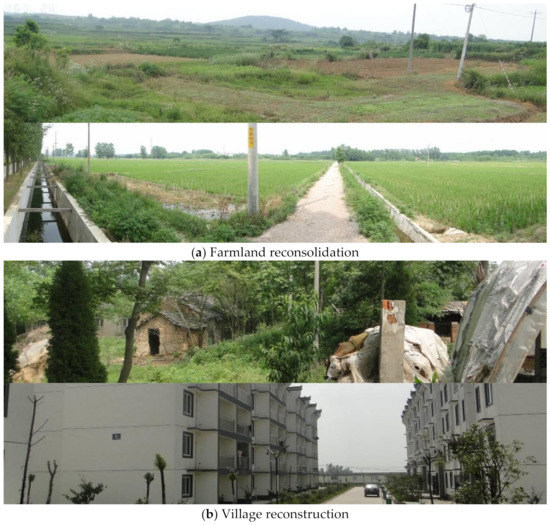
Figure 15.
Effect comparison of the project implementation. Under the guidance of the government and the participation of farmers, Pukou District implemented the construction project of “fertile farmland of million hectares”. It realized urban-rural integration development by farmland reconsolidation, village re-construction and factor reallocation. The effect is remarkable by (a) farmland reconsolidation and (b) village reconstruction before and after the implementation of the project.
5. Policy and Suggestions
5.1. Inspiring Farmer’ Willingness on Urban-Rural Integration
Although farmers in Pukou District have a strong desire to achieve urban-rural integration, social security function of the land is greater than production function of the land due to their love for the land. As a result, some farmers are worried about living security after relocation. If we forcibly demolish the old houses and resettle the farmers against the wishes of the farmers, many land and social problems will arise. The implementation of various land policies, such as linking the increase and decrease of urban and rural construction land, must respect the wishes of farmers and guarantee their basic rights and interests [50,51]. Only in this way can we get the support of farmers and promote urban-rural integration in an orderly way. On the one hand, the level of farmers’ culture and education influences the process of urban-rural integration. Farmers with higher culture and education level are more inclined to carry out farmland reconsolidation, village reconstruction, and factor reallocation. Therefore, it should improve cultural and educational level of farmers through various forms of education or training, and further stimulate their willingness to realize urban-rural integration. On the other hand, due to different willingness of farmers in different regions, the impact on the realization of urban-rural integration is not the same. In the optimization integration area, we should protect the interests of relocated farmers, consider life security after relocation, and safeguard legitimate interests of the farmers. In the key development areas, we should consider the production, life, and social security issues after unified residence of farmers. In the urban agricultural area and ecotourism area, we should pay more attention to the plot of loving the land, so as to enhance the willingness of farmers to achieve urban-rural integration.
5.2. Emphasizing the Role of Government in Urban-Rural Integration
At present, China has not really established a mature market economy, and the level of marketization is relatively low, especially in urban and rural market development. Therefore, this determines that the market is still in an auxiliary position and cannot play a leading role in the process of urban-rural integration, and the government will play a leading role. The government should first do a good job in urban-rural development planning, so as to guide the scientific and orderly development of urban and rural areas. We can effectively allocate urban and rural resources and optimize urban and rural space and industrial layout through urban-rural development planning. This will further play the leading role of urban-rural development planning in the process of urban-rural integration. This will effectively avoid large-scale farmland reconsolidation, largescale village reconstruction and other phenomena. The planning will speed up the process of rural industrialization and urbanization through macro-control and policy guidance. Once the plan is implemented, it will improve the living standards of farmers and narrow the gap between urban and rural areas. In particular, through land function zoning, the area will be divided into different land function areas. According to the characteristics of different typical rural areas in the region, operation patterns of land use in different regions should be implemented. In addition, according to different tools, we should implement different land use methods. For example, according to regional differences, we should take a differential way to renovate residential areas. Firstly, relocation mode of the whole village should be adopted in rural residential areas which are seriously restricted by natural environment. Secondly, villages with more idle rural construction land mainly adopt renovation mode of hollow village. Finally, natural villages with more rural settlements and scattered residents mainly adopt construction mode of central villages. Considering the strong love for land plot, the convenience of agricultural production and the continuity of traditional rural living habits, this should give priority to the settlement mode of concentrated living of nearby farmers.
5.3. Eradicating the Institutional Barriers in Urban-Rural Integration
According to the survey results of rural areas in Pukou District, large proportion of rural agricultural population has constrained the rapid development of rural economy, resulting in the difficulty of increasing farmers’ income. The key to harmony development of urban and rural areas lies in the rapid transfer of rural surplus labor. However, current urban-rural dual household registration system limits the transfer of rural surplus labor to non-agricultural industries. Therefore, we should gradually cancel the urban-rural dual household registration management system and implement a unified urban-rural household registration management system. Through the construction of a unified labor market in urban and rural areas, we will gradually form a sound mechanism for free migration of rural surplus labor. The government should actively cultivate and develop rural land-circulation market and provide necessary organizational guarantee for its development. A unified rural land-circulation service organization shall be set up to be responsible for the construction of rural land-circulation market. At the same time, we should improve operation standard of land circulation market, improve access system and exit mechanism of land circulation market, and ensure the healthy and orderly development of land circulation market. The government should solve social security problems of farmers. First of all, we should establish and improve the local laws and regulations of social security, such as rural minimum living insurance, pension, medical care, and so on. Secondly, we should focus on the implementation of various social security systems, improve the implementation of various laws and regulations, and effectively protect the rights and interests of farmers. In addition, we should protect the rights and interests of migrant workers, implement and improve the life security system of migrant workers, and gradually peel off the social security function of rural land.
5.4. Strengthening the Collective Ownership of Rural Land in Urban-Rural Integration
In the process of the investigation of farmer’s willingness in Pukou District, it is also found that after some rural collective land has been transformed into state-owned land, the landless farmers have obtained certain land compensation fees. However, because of the loss of land, they lost their life skills. As a result, their lives are not guaranteed, and they also express their willingness to maintain the collective ownership of rural land. At present, although the new generation of Chinese farmers gradually reduce their dependence on land, rural land is still their guarantee and dependence. Therefore, we should adhere to the collective ownership of rural land to provide institutional protection for farmers’ basic living rights and interests in urban-rural integration. Moreover, according to the investigation in Pukou District, the decentralized management of land limits the development of agricultural production and collective economy, and affects the improvement of farmers’ living standards. Therefore, we should rebuild collective public ownership of rural land and vigorously implement land-stock cooperative system. The land joint-stock cooperative system further clarifies farmers’ land-contract right and land-use right, and makes it valuable, which is conducive to the stability and improvement of land-contract management system. Due to that the land stock cooperative system makes clear the relationship of land property rights, it will arouse the enthusiasm of farmers and collectives. At the same time, land-stock cooperative system is conducive to the establishment of land circulation mechanism and land scale management, which can disperse the production risk of farmers. Once more, due to the collective ownership of rural land, farmers’ houses cannot be circulated and mortgaged, which seriously affects the process of urban-rural integration. Therefore, it is necessary to realize equal status of farmers and citizens in housing property rights, so as to establish a unified land market in urban and rural areas. “Entering the market” of rural collective construction-land will optimize the allocation of land resource elements. On the one hand, it will solve the excessive demand for construction land and effectively protect cultivated land resources. On the other hand, it will activate the idle construction land in rural areas and increase farmers’ property income. All these will promote new rural construction and rural revitalization, and promote urban-rural integration.
6. Conclusions
- (1)
- This study extends the theory of spatial interface to the urban-rural integration. It proposes three land use tools of “farmland reconsolidation–village reconstruction–factor reallocation”. The adjustment and optimization in the amount, structure pattern of urban-rural land use will eliminate the barriers of elements’ mobility between urban-rural systems and promote the two-way flow of various elements between urban and rural areas. It can achieve urban-rural integration goals of “life well-off, production prosperity, welfare share, and environment beauty”.
- (2)
- According to the combination of resource environment, development intensity and development potential, the study area can be divided into four land-use functional areas. The division provides an effective carrier for the flow of labor, land, capital and other elements in the urban and rural regional system. From the results of the survey and analysis of the willingness of farmers in the study area, most of the farmers have a strong willingness to realize urban-rural integration.
- (3)
- This study has carried out the basic reality analysis of urban-rural integration and the internal driving-willingness investigation of urban-rural integration in the research area. It proposes an operational pattern of land use. The pattern is mainly based on “reality + willingness + policy” by using the three tools of “farmland reconsolidation, village reconstruction and factor reallocation”. It achieves urban-rural integration through “zoning guidance–willingness driven–mode selection–differentiated tools”.
This article only makes a qualitative analysis on the regulation of urban-rural integration interface by land use. It preliminarily proposes an operational pattern of land use based on “reality + willingness + policy”. In the future, it is necessary to carry out a lot of field research and indoor analysis to establish a quantitative regulation model of urban-rural integration based on land use. It further analyzes the impact of land use on the urban-rural integration and its regulatory effect. In addition, the operational pattern is an urban-rural system engineering containing economy, society, environment, and other aspects. It involves the government, farmers, and other stakeholders. So the evaluation of the implementation effect needs to be further discussed.
Author Contributions
Conceptualization, S.Z.; methodology, W.C.; software, W.C.; validation, W.C., S.Z. and M.Z.; formal analysis, W.C.; investigation, W.C.; data curation, W.C.; writing—original draft preparation, W.C.; writing—review and editing, W.C.; visualization, M.Z.; supervision, S.Z. All authors have read and agreed to the published version of the manuscript.
Funding
This research was funded by Department of Land and Resources of Jiangsu Province of China.
Institutional Review Board Statement
Not applicable.
Informed Consent Statement
Not applicable.
Data Availability Statement
Not applicable.
Acknowledgments
The authors thank the editors and anonymous reviewers for their insightful comments and suggestions that helped improve this paper.
Conflicts of Interest
The authors declare no conflict of interest.
References
- Li, L.N.; Liu, Y.S. Spatial-temporal patterns and driving forces of sustainable urbanization in China since 2000. J. Urban Plan. Dev. 2019, 145, 05019014. [Google Scholar] [CrossRef]
- Ma, X.; Wang, F.R.; Chen, J.D.; Zhang, Y. The income gap between urban and rural residents in China: Since 1978. Comput. Econ. 2018, 52, 1153–1174. [Google Scholar] [CrossRef]
- Du, H.F.; King, R.B.; Chi, P.L. Income inequality is detrimental to long-term well-being: A large-scale longitudinal investigation in China. Soc. Sci. Med. 2019, 232, 120–128. [Google Scholar] [CrossRef] [PubMed]
- Ren, Q.; Huang, Q.X.; He, C.Y.; Tu, M.Z.; Liang, X.Y. The poverty dynamics in rural China during 2000–2014: A multi-scale analysis based on the poverty gap index. J. Geogr. Sci. 2018, 28, 1427–1443. [Google Scholar] [CrossRef]
- Li, Y.H. Urban-rural interaction patterns and dynamic land use: Implications for urban-rural integration in China. Reg. Environ. Change 2012, 12, 803–812. [Google Scholar] [CrossRef]
- Chen, D.; Wang, Y.X.; Ren, F.; Du, Q.Y. Spatio-temporal differentiation of urban-rural equalized development at the county level in Chengdu. Sustainability 2016, 8, 422. [Google Scholar] [CrossRef]
- Li, Y.H.; Hu, Z.C. Approaching integrated urban-rural development in China: The changing institutional roles. Sustainability 2015, 7, 7031–7048. [Google Scholar] [CrossRef]
- Wu, X.; Cui, P. A study of the time-space evolution characteristics of urban-rural integration development in a mountainous area based on ESDA-GIS: The case of the Qinling-Daba Mountains in China. Sustainability 2016, 8, 1085. [Google Scholar] [CrossRef]
- Chen, X.W. Review of China’s agricultural and rural development: Policy changes and current issues. China Agric. Econ. Rev. 2009, 1, 121–135. [Google Scholar] [CrossRef]
- Liu, Y.S.; Long, H.L.; Chen, Y.F.; Wang, J.Y.; Li, Y.R.; Li, Y.H.; Yang, Y.Y.; Zhou, Y. Progress of research on urban-rural transformation and rural development in China in the past decade and future prospects. J. Geogr. Sci. 2016, 26, 1117–1132. [Google Scholar] [CrossRef]
- Ma, L.B.; Chen, M.M.; Fang, F.; Che, X.L. Research on the spatiotemporal variation of rural-urban transformation and its driving mechanisms in underdeveloped regions: Gansu Province in western China as an example. Sustain. Cities Soc. 2019, 50, 101675. [Google Scholar] [CrossRef]
- Ma, L.B.; Liu, S.C.; Fang, F.; Che, X.L.; Chen, M.M. Evaluation of urban-rural difference and integration based on quality of life. Sustain. Cities Soc. 2020, 54, 101877. [Google Scholar] [CrossRef]
- Hersperger, A.M.; Gradinaru, S.R.; Siedentop, S. Towards a better understanding of land conversion at the urban-rural interface: Planning intentions and the effectiveness of growth management. J. Land Use Sci. 2020, 15, 644–651. [Google Scholar] [CrossRef]
- Huang, Q.H.; Li, M.C.; Chen, Z.J.; Li, F.X. Land consolidation: An approach for sustainable development in rural China. Ambio 2011, 40, 93–95. [Google Scholar] [CrossRef]
- Janus, J.; Taszakowski, J. Spatial differentiation of indicators presenting selected barriers in the productivity of agricultural areas: A regional approach to setting land consolidation priorities. Ecol. Indic. 2018, 93, 718–729. [Google Scholar] [CrossRef]
- Vargo, J.; Habeeb, D.; Stone, B. The importance of land cover change across urban-rural typologies for climate modeling. J. Environ. Manag. 2013, 114, 243–252. [Google Scholar] [CrossRef] [PubMed]
- Ivkovic, M.; Barkovic, D.; Bacani, S. Land consolidation and rural development. Geodetski List 2010, 64, 297–312. [Google Scholar]
- Jin, X.B.; Shao, Y.; Zhang, Z.H.; Resler, L.M.; Campbell, J.B.; Chen, G.; Zhou, Y.K. The evaluation of land consolidation policy in improving agricultural productivity in China. Sci. Rep. 2017, 7, 2792. [Google Scholar] [CrossRef] [PubMed]
- Wu, Y.F.; Feng, W.L.; Zhou, Y. Practice of barren hilly land consolidation and its impact: A typical case study from Fuping County, Hebei Province of China. J. Geogr. Sci. 2019, 29, 762–778. [Google Scholar] [CrossRef]
- Liu, Y.S.; Yang, R.; Li, Y.H. Potential of land consolidation of hollowed villages under different urbanization scenarios in China. J. Geogr. Sci. 2013, 23, 503–512. [Google Scholar] [CrossRef]
- Li, Y.H.; Jia, L.R.; Wu, W.H.; Yan, J.Y.; Liu, Y.S. Urbanization for rural sustainability–Rethinking China’s urbanization strategy. J. Clean. Prod. 2018, 178, 580–586. [Google Scholar] [CrossRef]
- Long, H.L.; Liu, Y.S.; Li, X.B.; Chen, Y.F. Building new countryside in China: A geographical perspective. Land Use Policy 2010, 27, 457–470. [Google Scholar] [CrossRef]
- Liu, Y.S. Introduction to land use and rural sustainability in China. Land Use Policy 2018, 74, 1–4. [Google Scholar] [CrossRef]
- Long, H.L. Land consolidation: An indispensable way of spatial restructuring in rural China. J. Geogr. Sci. 2014, 24, 211–225. [Google Scholar] [CrossRef]
- Long, H.L.; Zhang, Y.N.; Tu, S.S. Rural vitalization in China: A perspective of land consolidation. J. Geogr. Sci. 2014, 29, 517–530. [Google Scholar] [CrossRef]
- Li, Y.R.; Liu, Y.S.; Long, H.L. Community-based rural residential land consolidation and allocation can help to revitalize hollowed villages in traditional agricultural areas of China. Land Use Policy 2014, 39, 188–198. [Google Scholar] [CrossRef]
- Long, H.L.; Li, Y.R.; Liu, Y.S.; Woods, M.; Zou, J. Accelerated restructuring in rural China fueled by ‘increasing vs. decreasing balance’ land-use policy for dealing with hollowed villages. Land Use Policy 2012, 29, 11–22. [Google Scholar] [CrossRef]
- Alexander, C.; Ishikawa, S.; Silverstein, M. A Pattern Language: Towns, Buildings, Construction; Oxford University Press: Oxford, UK, 1977. [Google Scholar]
- Mehaffy, M.W.; Kryazheva, Y.; Rudd, A.; Salingaros, N.A. A New Pattern Language for Growing Regions: Places, Networks, Processes; Sustasis Press: Portland, OR, USA, 2020. [Google Scholar]
- Li, J.T.; Yang, Y.Y.; Jiang, N. County-rural transformation development from viewpoint of “population-land-industry” in Beijing-Tianjin-Hebei region under the background of rapid urbanization. Sustainability 2017, 9, 1637. [Google Scholar] [CrossRef]
- Kennedy, M.C.; Johnson, M.C. Fuel treatment prescriptions alter spatial patterns of fire severity around the wildland-urban interface during the Wallow Fire, Arizona, USA. For. Ecol. Manag. 2014, 318, 122–132. [Google Scholar] [CrossRef]
- Mei, K.; Liao, L.L.; Zhu, Y.L.; Lu, P.; Wang, Z.F.; Dahlgren, R.A.; Zhang, M.H. Evaluation of spatial-temporal variations and trends in surface water quality across a rural-suburban-urban interface. Environ. Sci. Pollut. Res. 2014, 21, 8036–8051. [Google Scholar] [CrossRef]
- Murphy, A.K.; Clennon, J.A.; Vazquez-Prokopec, G.; Jansen, C.C.; Frentiu, F.D.; Hafner, L.M.; Hu, W.B.; Devine, G.J. Spatial and temporal patterns of Ross River virus in south east Queensland, Australia: Identification of hot spots at the rural-urban interface. BMC Infect. Dis. 2020, 20, 722. [Google Scholar] [CrossRef]
- Chen, F.; Yu, M.; Zhu, F.W.; Shen, C.Z.; Zhang, S.L.; Yang, Y.J. Rethinking rural transformation caused by comprehensive land consolidation: Insight from program of whole village restructuring in Jiangsu Province, China. Sustainability 2018, 10, 2029. [Google Scholar] [CrossRef]
- Yu, Z.W.; Xiao, L.S.; Chen, X.J.; He, Z.C.; Guo, Q.H.; Vejre, H. Spatial restructuring and land consolidation of urban-rural settlement in mountainous areas based on ecological niche perspective. J. Geogr. Sci. 2018, 28, 131–151. [Google Scholar] [CrossRef]
- Strek, Z.; Noga, K. Method of delimiting the spatial structure of villages for the purposes of land consolidation and exchange. Remote Sens. 2019, 11, 1268. [Google Scholar] [CrossRef]
- Hong, C.Q.; Jin, X.B.; Fan, Y.T.; Xiang, X.M.; Cao, S.; Chen, C.C.; Zheng, G.; Zhou, Y.K. Determining the effect of land consolidation on agricultural production using a novel assessment framework. Land Degrad. Dev. 2020, 31, 356–371. [Google Scholar] [CrossRef]
- Moravcova, J.; Koupilova, M.; Pavlicek, T.; Zemek, F.; Kvitek, T.; Pecenka, J. Analysis of land consolidation projects and their impact on land use change, landscape structure, and agricultural land resource protection: Case studies of Pilsen-South and Pilsen-North (Czech Republic). Landsc. Ecol. Eng. 2017, 13, 1–13. [Google Scholar] [CrossRef]
- Muchova, Z.; Leitmanova, M.; Petrovic, F. Possibilities of optimal land use as a consequence of lessons learned from land consolidation projects (Slovakia). Ecol. Eng. 2016, 90, 294–306. [Google Scholar] [CrossRef]
- Uyan, M.; Cay, T.; Inceyol, Y.; Hakli, H. Comparison of designed different land reallocation models in land consolidation: A case study in Konya/Turkey. Comput. Electron. Agric. 2015, 110, 249–258. [Google Scholar] [CrossRef]
- Zhang, B.L.; Sun, P.L.; Jiang, G.H.; Zhang, R.J.; Gao, J.B. Rural land use transition of mountainous areas and policy implications for land consolidation in China. J. Geogr. Sci. 2019, 29, 1713–1730. [Google Scholar] [CrossRef]
- Huang, Q.D.; Xu, J.J.; Qin, H.; Gao, X.Y. Understanding land use and rural development in the national scheme of village relocation and urbanization in China: A case study of two villages in Jiangsu Province. Sustainability 2018, 10, 3227. [Google Scholar] [CrossRef]
- Sun, H.; Liu, Y.S.; Xu, K.S. Hollow villages and rural restructuring in major rural regions of China: A case study of Yucheng City, Shandong Province. Chin. Geogr. Sci. 2011, 21, 354–363. [Google Scholar] [CrossRef]
- Tan, M.H.; Li, X.B. The changing settlements in rural areas under urban pressure in China: Patterns, driving forces and policy implications. Landsc. Urban Plan. 2013, 120, 170–177. [Google Scholar] [CrossRef]
- Lu, N.C.; Wei, H.J.; Fan, W.G.; Xu, Z.H.; Wang, X.C.; Xing, K.X.; Dong, X.B.; Viglia, S.; Ulgiati, S. Multiple influences of land transfer in the integration of Beijing-Tianjin-Hebei region in China. Ecol. Indic. 2018, 90, 101–111. [Google Scholar] [CrossRef]
- Sun, Y.; Akiyama, T. An empirical study on sustainable agriculture land use right transfer in the Heihe River Basin. Sustainability 2018, 10, 450. [Google Scholar] [CrossRef]
- Xu, D.D.; Cao, S.; Wang, X.X.; Liu, S.Q. Influences of labor migration on rural household land transfer: A case study of Sichuan Province, China. J. Mt. Sci. 2018, 15, 2055–2067. [Google Scholar] [CrossRef]
- Zhang, X.; Jin, F.; Liu, P.D. A grey relational projection method for multi-attribute decision making based on intuitionistic trapezoidal fuzzy number. Appl. Math. Model. 2013, 37, 3467–3477. [Google Scholar] [CrossRef]
- Duan, X.J.; Chen, W. Primary study on the methods of spatial development function regionalization in province scale. Resour. Environ. Yangtze Basin 2005, 14, 540–545. (In Chinese) [Google Scholar]
- Gessesse, A.T.; Li, H.J.; He, G.; Berhe, A.A. Study on farmers land consolidation adaptation intention: A structural equation modeling approach, the case of Sichuan province, China. China Agric. Econ. Rev. 2018, 10, 666–682. [Google Scholar] [CrossRef]
- Wang, W.X.; Yu, L.H.; Zhou, W.; Marcouiller, D.W.; Luo, B. Estimating the mechanism of farmers’ effective participation in Chinese rural land consolidation. China Agric. Econ. Rev. 2019, 11, 100–124. [Google Scholar] [CrossRef]
Publisher’s Note: MDPI stays neutral with regard to jurisdictional claims in published maps and institutional affiliations. |
© 2021 by the authors. Licensee MDPI, Basel, Switzerland. This article is an open access article distributed under the terms and conditions of the Creative Commons Attribution (CC BY) license (https://creativecommons.org/licenses/by/4.0/).